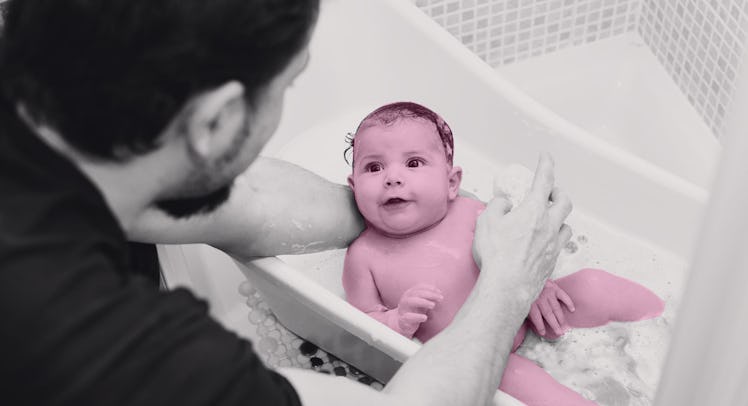How to Safely Use an Infant Bathtub to Get a Baby Clean
A portable baby tub can be much more comfortable for parents. All it takes is preparation and diligence.

It can be difficult – and dangerous – to wash a tiny baby in a regular bathtub. It’s hard on a parent’s knees, it’s hard on the lower back, and it’s hard to safely support a slippery, soapy infant. Baby tubs can be a much safer option. They are portable and can be used on any level, stable surface such as a countertop. Parents can clean the baby at a height that’s comfortable for them, which allows them to exercise more control of a baby who can’t yet sit up or support their own head. Even older babies with more developed motor skills can benefit from a baby tub since they are considerably safer than bath seats.
“The advantage to a small tub initially is your ability to hold the baby more securely versus awkwardly leaning over a bathtub with that hard surface,” explains Cari Hotchkiss, a registered nurse with six years’ experience in the Pediatric Intensive Care Unit and another five working in schools. “That said, you need to be prepared and have all the things you anticipate needing before you begin.”
First, parents should prepare their workspace. Towels and a gentle washcloth should be on hand, as should soap. It doesn’t have to be baby-specific; adult soap can be fine, as long as it is gentle and fragrance-free. A few clean and rinsed washcloths will be needed, too; at least one for applying soap and at least one for rinsing.
Because of their sensitive skin, the water temperature should be cooler than for an adult bath — around 100 degrees. If it feels too hot on the inside of the wrist, it is too hot for a baby. A few inches of water is all that is necessary; a washcloth will be able to do much of the wetting and washing.
Parents should position the baby so that their non-dominant hand is supporting the baby’s head and neck, and then gently lower the baby into the water. The key to bathtime safety — and the biggest benefit of using a baby tub — is being able to easily and ergonomically support the child, but it can have its drawbacks.
“Having a baby wet and slippery at counter height can also pose a danger,” cautions Hotchkiss. “Have an extra set of hands available the first time, if possible.”
How to Use a Baby Tub
- Be prepared! Have everything necessary ready before filling the tub.
- Not too hot, and not too much – two inches of water no warmer than a hundred degrees Fahrenheit is sufficient.
- Dedicate one hand to support the baby and do not let go.
- Wash face and scalp first, then body, then bottom.
- Wrap the baby securely in a towel and pat dry.
Parents should use their dominant hand to wash, and their other hand should go to the baby’s back to support their torso and head. The supporting hand should remain soap-free so it isn’t slippery. The other hand can be used for washing and rinsing. One hand needs to be on the child at all times; having a dedicated hand for support makes that easier to accomplish.
Parents should wash the baby’s face with a clean, damp washcloth, gently wiping the eyelids from the inside corner out. A different part of the washcloth should be used for each eye and to clean the nose, ears, and mouth.
Gentle soap should be applied to a washcloth and then used to wash the baby’s body and scalp. A little goes a long way. If the baby has enough hair to warrant shampoo, a single drop can be applied directly to their hair and gently worked into a lather. A clean, wet washcloth can rinse the hair and help keep suds and water out of their face.
Soap isn’t necessary to clean the groin area, but it should be wiped thoroughly and gently. Stool particles can get trapped in those chubby baby rolls and cause a serious problem later. For boys, the genitals need to be cleaned thoroughly and debris rinsed away, as well as inspected for adhesions. For girls, they need to be cleaned front to back with water only. Baby butts are adorable but should be cleaned last. Washcloths that clean a bottom shouldn’t be used for washing again until they go through the laundry.
When the bath is over, parents should gently wrap the baby in a towel and pat them dry. They can be diapered and dressed at the counter or in their room, but the key is to do all transfers with clear communication – remember, the counter and floor are pretty hard surfaces, too.“Assemble everything you need before beginning, and when you are done, make sure the infant is wrapped securely in a dry towel before handling over the floor,” Hotchkiss urges.
It can be nerve-racking the first time, but it doesn’t need to happen right away. Babies don’t need immersion baths – and shouldn’t have them – until the stump of their umbilical cord has fallen off, which takes about ten days or so. Daily bathing isn’t necessary either, although it isn’t harmful. The dirtiest parts of most babies are their faces and bottoms, and those should be cleaned as soon as they get dirty anyway.
This article was originally published on